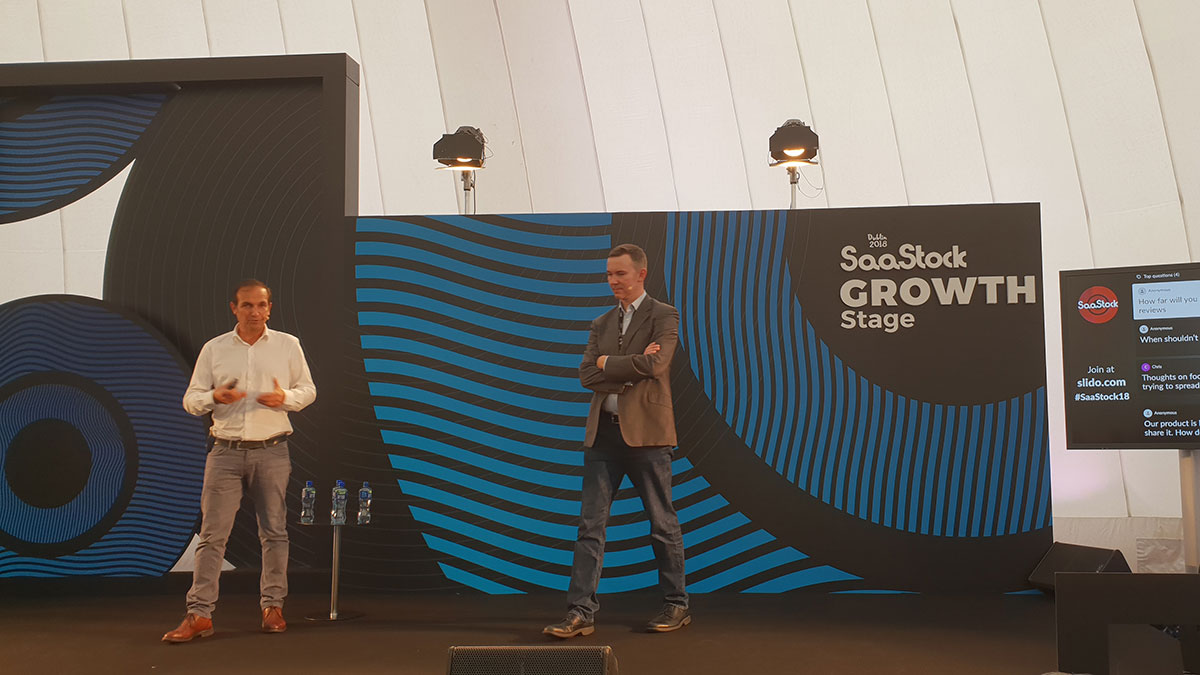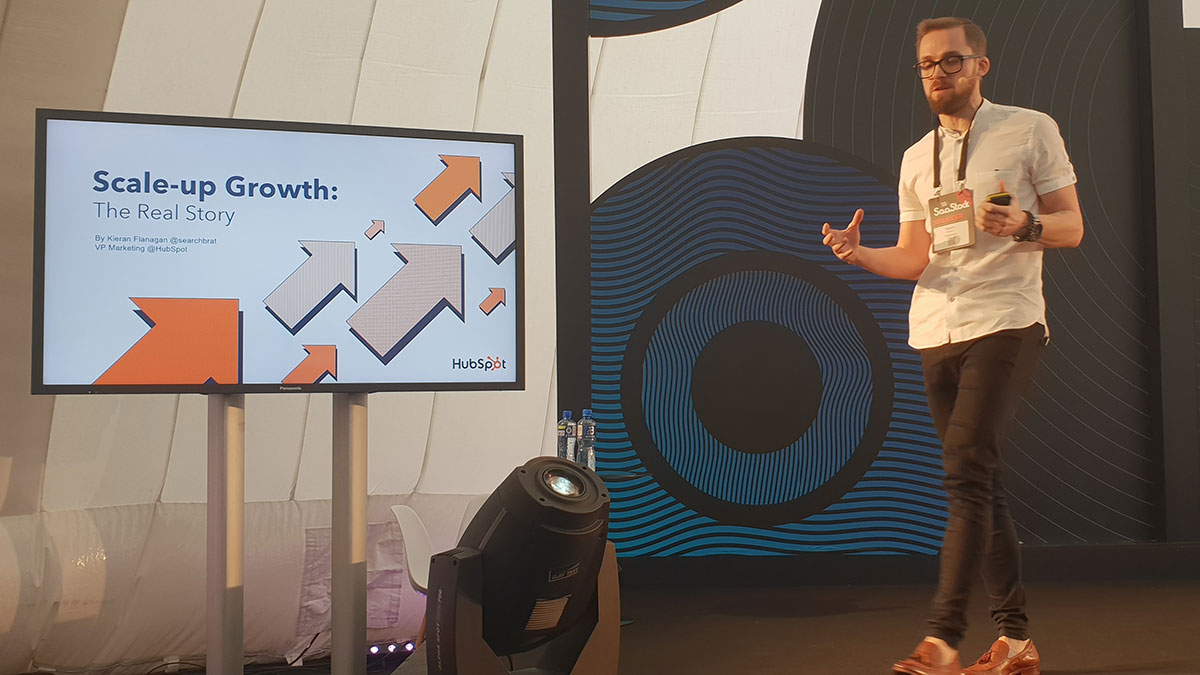The following article was prepared by Sebastian Lambert, CEO of FinancesOnline and an expert in the field of SaaS & B2B lead generation and growth hacking. All strategies are based on Sebastian’s personal experience at the SaaStock 2018 conference in Dublin.
The 2018 SaaStock conference hosted in Dublin has just ended and, in addition to an unexpectedly sunny Irish weather, it gathered a premium bunch of SaaS founders and market experts eager to share the strategies that allowed them to grow their products into success. If you didn’t have the chance to be in Dublin this year, don’t worry. In this article I’ll share with you some of the most interesting B2B strategies that we learned at SaaStock. Read on, to find more about the innovative ideas that will let your SaaS grow in the right direction.

What I think were the 5 best keynotes at SaaStock Dublin 2018:
- Nathan Latka – State of SaaS: ARR data from 1000+ private B2B SaaS companies
- David Darmanin from Hotjar – The rocky bootstrapped road from $10 million to $20 million ARR
- Judy Boniface-Chang from Mailjet – Stop. Collaborate and Listen: What Ice Ice Baby knew 25+ years before the SaaS industry
- Jada Balster from Workfront – Four critical success factors to consider when building a category
- Eric Santos from Resultados Digitais – Lessons from creating a movement and scaling a leading SaaS company in emerging markets

Nathan Latka in his data-driven keynote on “State of SaaS: ARR data from 1000+ private B2B SaaS companies”
10 Best B2B Strategies from SaaStock 2018
1. How to engage your potential leads with one simple tool
The first marketing idea comes from Eric Siu, founder of Single Grain, a popular marketing services agency. He suggested a simple trick that allowed him to significantly increase conversion from his signup form. It’s a neat tool called Privy, designed for ecommerce conversion optimization. Among its features you’ll find a spinning wheel that Eric used on one of his forms to engage users more and encourage them to share their email address. It’s a simple popup that gives your users some free prize in exchange for their email, e.g. access to a premium guide, or some training with your product, or a limited trial of your premium features. At first, it might seem like something not fitting the B2B market. In fact, Eric himself was sceptical at the beginning, but he decided to try it out, and after implementing it he was positively surprised at the increase in the number of signups he got from the form.
You can also try out a similar tool called Wheelio, which works in basically the same way.

This little spinning wheel on Single Grain site gave Eric a big increase in the number of signups.
2. How to make the most out of your webinar content
This tip comes from Eric Siu as well and it’s something that will allow you to attract more visitors to your online webinars. If you run webinar content for your product you might not be satisfied with the number of participants you get. Creating a webinar requires significant effort from your team, but once the live webinar is done, you can easily reuse it to get more value out of it.
Create a landing page with information about the webinar, add a registration form that will gather all the info you need from a potential participant and then direct them to a page with the webinar video you’ve recorded a while back. The trick is to email your users with a message that a new webinar is just about to be available, in let’s say 15 minutes, to create a sense of urgency to participate in an event they’re about to miss. Sure, the webinar might not be live anymore, but if you direct your users to a valuable video, they’ll be grateful for it in the end, and you’ll get some useful info about them from the registration form that you can then pass on to your sales team.

Eric Siu giving a keynote on “How to generate customers on autopilot for 2018 & beyond”
3. Don’t overextend your resources when testing new SaaS growth ideas
Kieran Flanagan, VP of marketing at HubSpot, shared some interesting insights on approaching new ideas for scaling up your business. He stressed the importance of not jumping at every SaaS growth idea that has potential, as it may easily lead to overextension of your resources. Instead, he suggested honing the ideas in the same way an tech incubator works. If someone in your company has a potentially good growth idea make him a co-founder for that idea and give them enough initial resources to test it at the incubation stage.
Kieran likes to use a 2×2 matrix to segment potential ideas based on the effort required in their implementation (horizontal axis) and potential ROI (vertical axis). This gives you four basic types of ideas:
- Scalable Growth: that’s the ideas you’re currently using as a foundation for your business model, they require a lot of company resources, but they’re tested and provide high ROI.
- The Gold: these are very rare and hard to achieve at the scale-up stage, so you’ll mostly encounter them with startups. These are ideas that offer high ROI at a low implementation cost. Obviously, you should definitely jump at opportunities like this.
- Incubator: that’s the segment you’ll want to use for most of potentially good growth ideas. The ROI potential is still low, because they’re not tested yet, but allocating little resources to it will allow you to patiently incubate and evaluate each idea in a safe environment.
- Black Holes: these are ideas that take up a lot of company effort while offering poor ROI. Avoid them at all costs.

Source: https://twitter.com/searchbrat
In the end, your objective should be to start with your ideas in the Incubator box and attempt to move them to the Scalable Growth box. For each idea make sure you evaluate:
- Potential: how soon you’ll hit a growth ceiling with it
- Importance: how vital is this idea to the healthy growth of your company
- Ease of implementation: how fast can you implement it and how many resources it will require
4. Make sure your SaaS is positioned in the right market category
April Dunford, an expert in startup marketing and positioning, shared some of her early experience with how important is to realize which market category your SaaS fits best. The basic idea you started with may have been improved and changed over time in a dramatic way, and quite often you may end up with a product that belongs to a completely different market. She offered an example of a database startup that couldn’t get a proper investor, because everybody was already using some database solution and Oracle dominated that market. However, when she refocused the product on a different market, and framed it as a business intelligence solution and a data warehouse, it allowed their unique features to shine.
Start with an open mind and don’t assume automatically that your product belongs to a specific SaaS market. Instead, ask yourself, what is the key differentiator of your product? Then, see what’s the market where key features of your product are expected and most valuable. The answer might surprise you.
This creates and opportunity to enter a completely new market where you may be more competitive than before, either because the leader on this new market sucks and you can already to things better than them, or because there isn’t a clear leader on this market yet and you can easily disrupt it with your ideas. The other idea, though a time-consuming one, is to put your effort into creating a completely new market that didn’t exist before, where you can obviously be the leader from the get go.

April Dunford showing how huge the SaaS landscape has become now.
5. Be authentic, even if you have to automate your marketing
Dave Gerhardt, VP of Marketing at Drift, an awesome live chat solution, stressed the importance of being authentic and human in your relations with customers. In addition to completely getting rid of stock images on his website he offered a great suggestion for automating your email marketing. Just be honest, admit that it’s an automated email, most of your clients will have recognized that anyway. However, this will allow them to see an actual, human person behind the message and connect with them more. Dave had some pretty spectacular results with this automated email:

Source: drift.com
6. Boost the efficiency of your email marketing
Steli Efti, CEO and co-founder of Close.io, gave some great advice on how to improve the efficiency of your email marketing. While many of it may seem obvious at first many SaaS sales and marketing teams still forget about using those tips in their emails:
- Always remember about the subject line. After all, what’s the point of writing a great email if nobody opens it in the first place. Don’t turn the subject line into a sales pitch or a click-bait. Don’t trick them into opening your email either.
- Make sure the contents of your email are easy to scan. Your client is busy and most likely won’t read the entire email. Make life easier for them and ensure they can easily scan your message for the most important stuff.
- Use only one CTA. Never ask the recipient to do more then one thing with your email. Decide what action you want them to take after they’ve read your message and ask them to do that. Be reasonable with your request. Obviously, having no CTA in your email is even worse.
- Explain who you are and why you’re credible. Don’t assume the recipient will be interested in your message. Start by explaining who you are and what you want from them. That’s not enough though, you should also explain why you’re a credible person and why they should trust you. Make sure you offer some trust-building element in your email.
- Follow up on all your emails. In most cases you’ll get a response only after several follow-ups, so always have a follow-up template ready to be sent. You should send a lot of those too. Steli suggests 8 follow-ups for cold contacts and for warm ones basically following them up forever until they reply.
- Get feedback from the replies. When you succeed and people reply to your email don’t waste that opportunity by going straight to business. Ask your potential clients about why they responded to your email. This data might be priceless, and most of them will gladly share their experience with you.

Steli Efti in his rock star performance on “How to design a killer SaaS sales email”
7. User reviews can be your great advantage
Fraser Stark, VP EMEA at Influitive gave a great presentation on the importance of user reviews in the SaaS buyer journey. Here are the key takeaways from him:
- As much as 33% of SaaS buyers are not confident when choosing a software.
- The main difficulty when looking for SaaS solutions is lack of time to do extensive research. That’s why a convenient comparison and review platforms like FinancesOnline are very important to them.
- Buyers often complain they don’t have enough information to calculate the actual cost of a product and they are concerned they will pay too much. This highlight the importance of offering transparent pricing for your product.
- SaaS buyers look for advice mostly on online communities and marketplaces like FinancesOnline, G2Crowd or Capterra. Make sure your SaaS is present on all of them for maximum exposure.
- Most of SaaS buyers will start a few free trials first. You can be sure that your product will be compared against a few other options before your potential client chooses one of the solutions.
- 80% of buyers admit reviews are a key factor in their buying decision. They will read up to 8 reviews first with special attention paid to pros and cons sections (though pricing and integrations are also important to them). 85% of buyers will trust reviews as much as personal recommendations.
- To work in your advantage user reviews must be recent (from last 6 months). Quality of writing is also important, short reviews with little detail will do you no good.
- Quantity also matters. Get at least 50 reviews, this can impacts conversion rates by as much as 4.6%

8. User reviews can be an inspiration for your content marketing
Ryan Bonnici, CMO at G2Crowd, offered a lot of interesting ideas on how to push your SaaS even further. He explained that because user reviews and peer experience are the most popular types of B2B content, reading user reviews of your product on various review platforms can actually be a great source of inspiration for new content topics that will attract more traffic to your website. Just spend some time exploring what your users are curious about or what problems they’re facing and write about it to offer them some solutions and answers.
What is more, negative reviews can actually boost your credibility, but you have to make sure you respond to them. Luckily, FinancesOnline allows all registered vendors to post a reply to every user review on your product page, so it’s a great way to touch base with your clients and address any issues they may have. Even if you don’t convince that particular client, other potential ones visiting your review page will see that you reply to such concerns and treat your users seriously.
In general, it’s always a great idea to ask your users for reviews in your customer care process.

Peer experience and user reviews are among the most popular types of content among B2B buyers
9. Early onboarding for your customers matters
This one comes from Kieran Flanagan from HubSpot. In his marketing growth bootcamp training during the SaaS.City event he stressed the importance of onboarding your users as early as possible. Ideally, you should offer them clear and focused onboarding in the very first email they get after signup. What is more, make sure the orientation gives them the right AHA moment when they realize the key benefit of your product. If you don’t show them that benefit from the get go you risk they will not discover it on their own and will lose interest before they truly start to appreciate your product.
When you do that keep in mind that your onboarding should lead your fresh user straight to the most unique and beneficial function of your SaaS. It might be tempting to show them how many exciting new features you have for them to try out, but the truth is you want to direct their attention to that very special one that will turn them from free trial signups into loyal customers.

10. Make sure you have the right person as your CMO
In a really interesting discussion titled “The role of the CMO in the fourth industrial revolution: Tech, trends & transitions” a panel of four CMOs of big SaaS companies: Eileen O’Mara from Salesforce, Heather Zynczak from Pluralsight, Meagen Eisenberg from MongoDB and Ryan Carlson from Okta; discussed how difficult it is in the current SaaS landscape to find the right team for your company.
When asked about the qualities a great CMO for a SaaS company should have they gave several interesting points of insight:
- They stressed the importance to always hire people smarter than you in their given fields. As a CMO you should be able to effectively manage and synergize their knowledge and your own experience to create a smoothly working marketing machine.
- Make sure you’re a data driven CMO with a strong tech mindset. Marketing has changed over the years, and today making the right calls is almost exclusively based on gathering and interpreting data.
- Always make sure that sales drive your marketing pipeline. Many CMOs seem to think their ultimate goal is generating MQLs, while in fact it should be SQLs that you should be focused on as these are the leads good enough for the sales team to actually push down the sales funnel.
- Know when to switch from generals to specialists as you grow. It’s important to have people with general skill sets at the early stages of development, when you have few employees, but as your company grows, you must find the correct moment to start specializing your team in specific areas.

4 CMOs discussing “The role of the CMO in the fourth industrial revolution: Tech, trends & transitions”
What was the best thing
you’ve learned at SaaStock in 2018?
Let us know in the comments!


 The following article was prepared by
The following article was prepared by 




















Leave a comment!